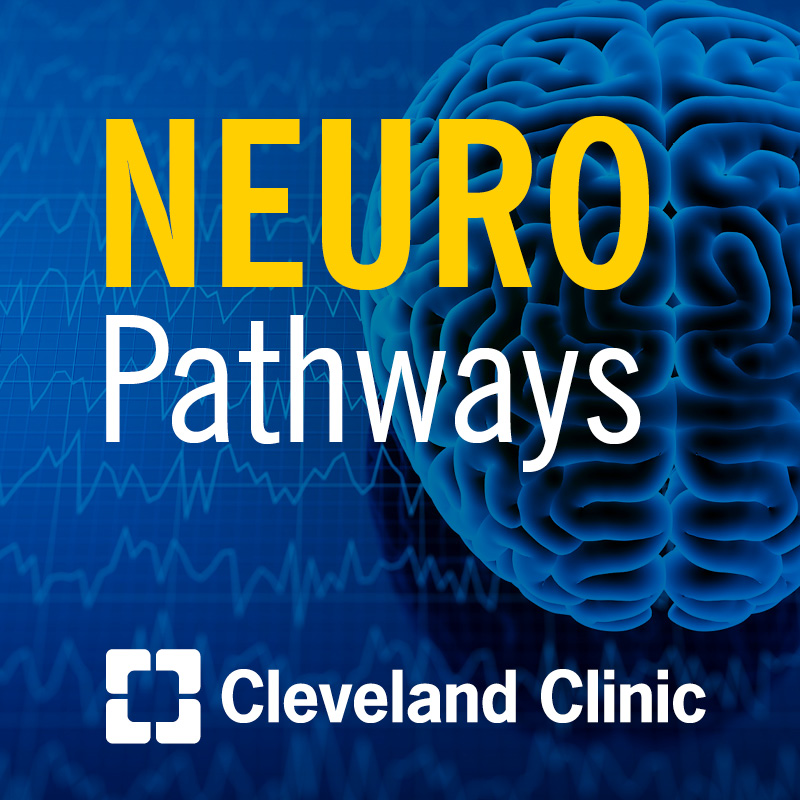Expanding Cancer Treatment with Theranostics

Theranostics is changing the way we approach cancer care by combining advanced imaging with targeted therapy. Elcin Zan, MD, Chair of the Department of Nuclear Medicine at Cleveland Clinic joins the Cancer Advances Podcast to discuss how theranostics is being used in prostate cancer, for neuroendocrine tumors and its potential use for other cancers.
Subscribe: Apple Podcasts | Podcast Addict | Buzzsprout | Spotify
Expanding Cancer Treatment with Theranostics
Podcast Transcript
Dale Shepard, MD, PhD: Cancer Advances, a Cleveland Clinic podcast for medical professionals exploring the latest innovative research and clinical advances in the field of oncology.
Thank you for joining us for another episode of Cancer Advances. I'm your host, Dr. Dale Shepard, a Medical Oncologist, Director of International Programs for the Cancer Institute, and Co-Director of the Sarcoma Program at Cleveland Clinic. Today, I am happy to be joined by Dr. Elcin Zan, Chair of the Department of Nuclear Medicine here at Cleveland Clinic. She's here today to talk about theranostics in oncology. Welcome.
Elcin Zan, MD: Thanks for having me.
Dale Shepard, MD, PhD: Give us a little bit of an idea of what you do here at Cleveland Clinic.
Elcin Zan, MD: At Nuclear Medicine, we primarily provide diagnostic services, which includes general nuclear medicine studies and PET scans. Our workforce in PET-CT is a FDG-PET, which can be used for any type of cancer. However, in certain cancers, such as prostate cancer and neuroendocrine tumor, it doesn't work that well. And for that purpose, we have more sophisticated PET-CT scan tools which use targeted receptor approach.
Let's talk about prostate cancer. We identify a receptor, namely PSMA, that is over-expressed by prostate cancer cells, and we do have a radiotracer that, once given to a patient, can go and hunt these receptors and find where the disease hubs are. And once we do the PET scan for these patients, then it becomes very apparent under the PET scan, when we look at the images on our monitors, where the disease is residing.
Similarly, in the neuroendocrine tumors, our target receptor is somatostatin receptor type two, which can be traced by the radionuclides. And again, same analogy, under the PET-CT camera, we can image those patients successfully and better in comparison to the routine diagnostic exams.
Our second line of service at the Nuclear Medicine is a new discipline called theranostics.
Dale Shepard, MD, PhD: Tell us a little bit about what exactly is theranostics.
Elcin Zan, MD: Theranostics is a contracted word. It's therapy and diagnostics. It is a part of precision oncology, as we keep hearing nowadays. We make sure that if we were treat a patient with any type of radiotherapy, we want to make sure that they do have the target receptor expression. How do we do that? For any given disease ... Let's talk about prostate cancer. Once we have a target receptor expression, namely PSMA, we come up with a ligand. Could be a peptide. Could be a small molecule. Could be an antibody. And that ligand is going to be already labeled with a positron emitter so that we can image the patients under PET-CT scanners or a heavy particle, such as beta or alpha. The first step is imaging a patient with our dedicated PET-CT tools.
The second step is treating those patients with particle radiation, which could be beta particle from lutetium-177 or alpha particle from actinium-225 or Auger electron from Terbium-161. Our basic aim is to create double-stranded DNA break with alpha particle, but this is not possible all the time. Let's take another look to Terbium-161, which is an Auger electron emitter. Our aim is to be able to puncture the membrane and maybe create more inflammatory way of killing the cell. With the FDA-approved product, lutetium-177, we create a cellular toxicity through single-stranded DNA break, but at the same time, we know there is a lot of new antigen expression during that time through the cell damage, so different ways of killing the cells, but our main focus is double-stranded DNA break, if not single-stranded DNA break, but at the same time, how can we create this radiotoxicity that can expose new antigens to the immune system?
And for that purpose, you will see many new clinical trials focusing on combination therapies, not only giving radiopharmaceuticals but combining it with, for instance, checkpoint inhibitors or sometimes even vaccines. We're practicing precision oncology in actuality.
Dale Shepard, MD, PhD: Turning the new PET techniques, like PSMA PET, into a way to actually treat prostate cancer.
Elcin Zan, MD: That's correct. In PSMA PET, when we image those patients, we use radionuclides such as gallium-68 or fluoride-18. These are non-ionizing type of radiations. They only help us to image the patients on their PET-CT camera. And once we see the receptor distribution, then we know the patient is a good candidate for the PSMA targeting therapy.
For therapy purposes, we use two different types at the moment. One is lutetium-177, which is a beta particle emitting radionuclides, and this is FDA approved. But in the research space, right now we are exploring multiple different types of radionuclides, namely alpha particles, Auger electrons, and when I say alpha particles, it's not only one particle, but it is a group of alpha particles such as actinium-225, astatine-211, lead-212, and so on. At the Cleveland Clinic right now, we are delivering theranostics therapies which are FDA approved for prostate and prostate cancer and neuroendocrine tumor patients.
But at the same time, we are opening multiple clinical trials using beta and alpha particles in different disease groups such as melanoma, Merkel cell carcinoma, meningioma, neuroendocrine cancer, small cell lung cancer, colorectal cancer. Theranostics is a discipline that can be applied to multiple cancer groups because, once you identify target receptor expression, you can tailor your radioligands to find that receptor with different types of radiation that is loaded on them, which the technical term we use for this is radiolabeling. You can radiolabel almost any compound that can be a peptide antibody small molecule. And once you radiolabel with imaging agents, if you see receptor distribution, you simply change this type of radiation on this ligand and make it a therapy agent.
Since we give therapy to the patients who express the intent to treat target receptors, our therapies are validated, and the side-effect profile is really patient-friendly.
Dale Shepard, MD, PhD: How's the decision making in terms of type of radiolabels? There's two parts. There's the what it's going to bind to, the receptor, and then there's sort of the payload, if you will. It seems in some of the areas like actinium's becoming, I'm seeing more trials with actinium. Previously, we were talking about things with lutetium, for instance.
What drives what type of label is used for these?
Elcin Zan, MD: The first radioligand trial phase one was NETTER-1 and studied the efficacy of somatostatin receptor type two targeting radioligand with lutetium-177, which is a beta-imminent particle, in grade one, grade two, progressive neuroendocrine tumors of midguts. These patients received the study drug after progressing most of the time long-acting octreotides. And it focused on studying radioligand therapy in comparison to standard of care radioligand therapy was given with 30-milligram long-acting octreotide in comparison to standard of care, which was 60 milligram of long-acting octreotide.
And the primary endpoint was met. Despite the fact it was efficacious, oral survival was not that different. That led to NETTER-2 trial design. So NETTER-2 trial studied the lutetium-177 somatostatin receptor type two targeting drug composition in the G2/G3 as a first line in comparison to the standard of care. This was found to be efficacious as well, and the overall survival data is still being accumulated. This is in the neuroendocrine tumor world.
When we switch to the prostate cancer, you probably are familiar with the VISION trial followed by PSMA-4 PSMA addition. All these trials are trying to study the radioligand therapy, the theranostics approach, in earlier and earlier disease groups. Because VISION focused on metastatic castration-resistant prostate cancer that has already been on the androgen deprivation therapy and one or two lines of taxine.
Right now, we're looking into, all right, VISION was successful, but it was not curative, so we are looking into right now how can we use radiopharmaceutical therapies in earlier disease stages prior to taxine, prior to chemotherapy, maybe even in comparison to the androgen deprivation therapy. Right now, there are multiple trials going on in that space. No finalized trials yet showing the head-to-head comparison in really early disease stage.
Dale Shepard, MD, PhD: You mentioned about more powerful radiation. Is that the concept to try to get alpha particles, which are the bigger particles, as a payload rather than the beta emitters? Is that one of the big drivers for changing?
Elcin Zan, MD: So far, alpha particles have been trialed in the most common setting. One, the patients. First of all, these are all clinical trials, but the most common setting is if a patient has failed beta particle therapy under FDA-approved standard of care. The difference between alpha and beta particle is alpha particle is a very powerful form of radiation compared to beta.
There is a definition called RBE, relative biologic effectiveness. In alpha particles, relative biologic effectiveness is way powerful than beta. As the medical physicists will say it, these is five times more. In that sense, you can think of delivering radiation to a tumor cell with alpha particle more powerful, destroying it in a more powerful way. However, in the same sense there are some other differences. For instance, there is a definition called the path length, which means that from the location you deliver your radiation particle, radioactive particle, from the time you deliver it to the time it decays, there is a certain path length that it takes.
And that path length identifies the bystander effect of your drug composition. In beta particle, we know the path length is around, give or take, two centimeters, but in alpha a particle, the path length is within a few cell diameters. We're studying the differences and taking the advantage of that difference because, for instance, if you have a bone marrow lesion, maybe alpha particle is a better option because your bystander effect will be less. Your path length is way less. Your off-target treatment effects will be way less, so to say, toxicity, as opposed to beta particle being more efficacious in tumors that are larger than a few centimeters. Because you want to take the advantage of the path length to deliver, to deploy, your radiation within a few centimeter of diameters with the beta particles.
In the trial designs right now, we are trying to move one step ahead and try to identify are there any biomarkers that we can use in those patients when we try to make decision between giving them, treating the patients with beta particles versus alpha particles. And in that sense, until now, PET scans were our only decision-making tools. For instance, if a patient has target receptor expression on the PET scan, "Sure, go ahead and give the therapy," was the idea. But right now, we're focusing on, wait a minute. Is this bone-heavy metastatic disease to treat? Is it liver-heavy metastasis to treat? If it's liver heavy, how big are the tumors? How big are these masses to be treated?
It's a complex decision-making process, but this is why we are right now studying all these combinations with different clinical trials.
Dale Shepard, MD, PhD: In general, are bone lesions more difficult to treat because of concerns for bone marrow toxicity and bone marrow suppression?
Elcin Zan, MD: That's our primary concern. In the radioligand therapy, we do focus on three organs, the kidney, liver, and bone marrow, to manage the toxicity profile. Bone marrow, in the most common setting in the radiopharmaceutical therapies, the cytopenias are quite common, but they're luckily grade one or two. But on the other hand, in the clinical trials that I mentioned, there has been cases of MDS, mild dysplastic syndrome. In that sense, we are trying to be as gentle as possible with the bone marrow toxicity.
For kidney neuroendocrine tumor patients, we do co-infuse the radiopharmaceuticals, the radioligand therapies. Another term you'll hear is PRRT, peptide receptor radiopharmaceutical therapy. We co-infuse the drug with amino acids for renal protection. We are studying how to best protect the organs that are more prone to develop toxicity as kidney. But for bone marrow, we don't have much to offer right now.
And for liver, it's a more complex conversation for neuroendocrine tumors. However, not much of an issue with prostate cancer patients.
Dale Shepard, MD, PhD: We talked about PSMA with prostate, somatostatin with neuroendocrine tumors, and then you mentioned sort of things being developed for other cancers. What are some of the other markers that look interesting right now in terms of targets?
Elcin Zan, MD: I think the portfolio is real large, but I will try to provide a few practical answers to that.
Let's focus on skin cancers. For melanoma right now, there is a trial that is yet to open targeting melanocortin receptor one. And one of the most difficult disease to treat, UV melanoma, will be included in that trial.
In the GI cancers, we have a trial that is going on right now that targets EGFR and c-MET with an bispecific antibody. And in the small cell lung cancer and Merkel cell, which both seem to overexpress somatostatin receptor type two, we have a trial that is going to use an antagonist peptide, namely LM-3, to combine with actinium particle in that sense. Radiopharmaceutical therapy, the radiopharmaceutical drug, in actuality, is a composition of ligand and the radioactivity. You can switch the ligands in any way you want, shape or form, peptide, antibody, small molecule, and same way you can switch to radionuclides in the way you want. You can use actinium. You can use lead-212. You can use terbium-161, which is very exciting.
In that sense, when we approach to these therapies as radiopharmaceuticals, it is really an umbrella term.
Dale Shepard, MD, PhD: Certainly, as you just mentioned, there's the target, the marker, there's the radioactive payload, but then there's a linker between them. And you mentioned before about radioactive decay. I guess that would be the decay of the isotope itself.
But are there problems with these in terms of stability of the overall construct and as you deliver to patients having the radioactivity come free from the target, if you will?
Elcin Zan, MD: Very good question. Let's talk about the composition of a radiopharmaceutical. We have a ligand that is linked to the radionuclide, but the radionuclide is already kept in place stability through a chelator. In our drugs, except Lutathera, which is a lutetium-177 somatostatin-targeting drug composition ... In all of our drugs, we do have a chelator you can think of as a cage that keeps the radioactivity in place before it decays, so there is no leakage to the blood, so to say. And the chelator's primary job is to keep radioactivity in place. Linker's primary job is to make sure that radioactivity is connected to the ligand.
Yes, we do deal with these type of loss of the chelation after a drug is given into a patient. And for that purpose, there are multiple new chelators actively investigated in different drug compositions for stability. But at the same time, there are multiple different linkers that are being investigated as well. And that brings another complexity. There is no one type of radiopharmaceutical drug that fits all.
Dale Shepard, MD, PhD: Just from strictly from a patient perspective, I get patients who don't want to get a quarterly CT scan for surveillance. What kind of patient responses do you get when you're talking about a therapy where you're injecting radioactivity? How do those discussions go?
Elcin Zan, MD: We talk about the radiation safety and make sure that they understand strict rules to follow within the next three days of their drug infusions. We tell them to stay away from their loved ones for three days, keeping three-feet distance, using a separate bathroom, and try to stay away as much as possible. But the amount of radioactivity that we give to the patients ... Almost 90% leaves the body within 24 hours. The rest keeps doing its job over an extended period of time.
One of the most important conversations is, if they plan on taking a flight, they may set off the alarms. And then they will need to carry a radioactivity badge. We give them a badge that shows how much and what type of radiation that they have received so that they can use it if they are planning on flying. Because we do receive patients from out of state. They come to us. We treat them. Then they stay in Cleveland for a while. And after three days, they're ready to fly back.
And our therapies are given outpatient. The neuroendocrine tumor therapies are given over four hours because the nephroprotection, the amino acid given for nephroprotection, takes four hours, but the actual drug is infused over 30 minutes. Prostate therapies take around 15 to 30 minutes. Those are very short infusions. And we usually do not deal with immediate side effects such as nausea, vomiting, but most of the time, and the most common side effect is fatigue, which starts to kick in around 24 hours.
And we do not create or cause so much hair loss. It's not like chemotherapy. And we try to explain it to the patients. It's not chemotherapy. It's not external beam therapy. It's a type of liquid radiation.
Dale Shepard, MD, PhD: Well, certainly a lot of interesting things going on. Looks like a lot of potential. And I know you're setting up a lot of clinical trials, and so we'll look forward to a lot of interesting things in the future. Thanks for being with us.
Elcin Zan, MD: Thank you very much for having me.
Dale Shepard, MD, PhD: To make a direct online referral to our Cancer Institute, complete our online cancer patient referral form by visiting clevelandclinic.org/cancerpatientreferrals. You will receive confirmation once the appointment is scheduled.
This concludes this episode of Cancer Advances. For more podcast episodes, visit our website, clevelandclinic.org/canceradvancespodcast. Subscribe on Apple Podcasts, Spotify, or wherever you listen to podcasts.
Thank you for listening. Please join us again soon.


